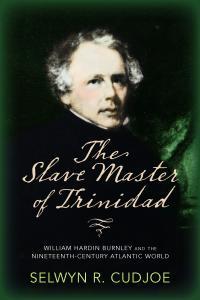Landscape, family and memory
Dr By Selwyn R. Cudjoe
Submitted: December 25, 2022
Posted: December 27, 2022
Today is Christmas Day. Let us give thanks and praise to the birth of a wonderfully well-researched book, Via the Round About, written by Beverly Scobie. It traces one part of Scobie's family, beginning with Joseph Arthur, the patriarch, who was "enslaved for all of his formative years".
Scobie is ambitious. She wishes to tell of "The Scobie Family's Story of Resolve and Resilience from 1819 through Emancipation, the Colonial Era, and Beyond". Although this is quite a bit to chew, Scobie keeps our interest all along this magnificent journey, entertaining and enlightening us as she tells her story.
This beautifully crafted book is enhanced by the well-preserved family portraits, her photographs of the area, and the diverse richness of the Paria archives. In it, Scobie integrates the growth of her family with the development of Toco and the surrounding villages where she grew up.
Scobie's family history starts with Peter Cordner who, in 1866, travelled from Tobago to the cocoa estates of Sans Souci, Toco to seek employment. She says of this perilous journey to Trinidad: "He and his fellow labourers continued to risk their lives traveling by small boats on the high seas, the only means of getting to cocoa estates."
Thereafter, Scobie gives us a ball-by-ball description of her family's development, their achievements, and their failures. She speaks of the pioneering work of some of her family members (such as Isaac and her father) and even the prevalence of mental diseases that affected family members, particularly Mary, her grandmother.
The bold adventures of her forebears allow Scobie to display her rich literary imagination. She writes: "When Peter Cordner first arrived, the region was still predominantly virgin forest, sparsely populated and isolated from the rest of Trinidad. The outlines of tiny enclaves were barely visible in areas where forests had been cleared. There were no lights, so that at nightfall it became pitch black and silent, except for the occasional flame of lighted flambeau. There were no roads and labourers walked for miles, most of the time barefooted, through densely wooded forests on dirt paths created by the footfall of the First People."
Scobie's description of the funeral rituals in the village is one of the most attractive aspects of her story—the preparation of the corpse for burial, the wake scene that included limbo and bongo dancing, the prayers that were rendered, and the pall-bearing rituals. These stirred my memories. When my father died in 1954, all of his children and close cousins were passed over his corpse three times as it lay in our living room.
Scobie's recollection of those innocent days of yore when adults and children looked forward to moonlit nights is also memorable: "Silly as it sounds, trapping candle-flies in a glass bottle and pretending it to be a lamp was really entertaining to children back then. But they made sure to avoid any larger than usual candle-fly, convinced that it might be a Soucouyant. This was especially so, after hearing the stories of the adults who told tales rooted in folklore and legends of the islands. Stories of Papa Bois, the old man of the forest who protected the animals from hunters; Soucouyant, the old lady of the vampire family who would suck your blood while you slept; La Diablesse, the spirit of the wronged woman whose alluring dress concealed one cloven hoof; and Duenne, the baby who died without the benefit of baptism. These and a host of other frightful creatures who lived amongst the villagers, unseen."
She also describes the native delicacies she ate, the games children played, and all of those intangible things that made those early days so special. The visual beauty of the matapal tree, the sumptuous nature of the home-made toolum and the bene balls, make the reader want to grab them and eat them off the pages.
One would be remiss if one did not speak of the central role that the Seventh-Day Adventist religion played in the lives of her family and the discipline that it imposed upon them. She says: "My parents were not well-off, but we lacked nothing. My father's faith was the foundation on which his life was built. It taught him to be disciplined and industrious. The strict routine practised in our household when I grew up was Daddy's letter of the law interpretation of religious doctrine espoused by the Seventh-Day Adventist denomination."
In 1947, Melville and Frances Herskovits, famous anthropologists from Northeastern University of Chicago wrote a book, Trinidad Village, that won much acclaim. Well versed in the study of black life, they wrote about the Africans in Toco. Harold E Davis, in a wonderful review in Boletín Bibliográfico de Antropología Americana, praised them for the use of "a matured methodology based on clearly defined theoretical concepts, for this community of New World Negroes. Especially notable is the clarity of their theoretical concepts. As a result, this study of the culture of the Negro Village of Toco... has unusual value both for the cultural anthropologist and for the historian of New World cultures".
Scobie's book may be lacking in the use of theoretical concepts, but she tells a story that is worthy of any anthropologist, historian or casual reader who is curious about our past.
Via the Round About is not an ordinary book. There is a beauty and innocence that is especially welcomed at a time when there is so much brutality in our island, and our people are unable to appreciate their beauty and their truth.
Therefore, congratulations are in order for Beverly Scobie for showing us this magnificent slice of our island and our people at a time at which it is so needed.
Prof. Cudjoe's email address is scudjoe@wellesly.edu. He can be reached @ProfessorCudjoe.
Share your views here...

The Slave Master of Trinidad by Dr. Selwyn R. Cudjoe
|

